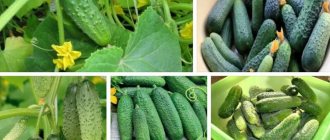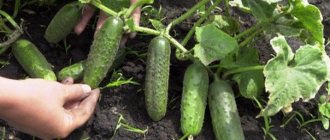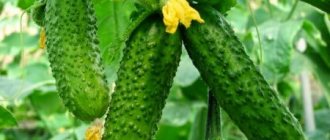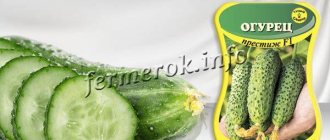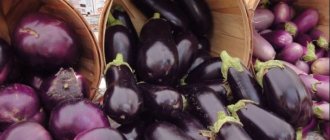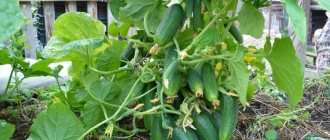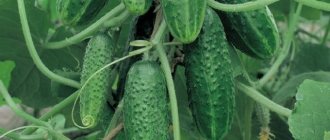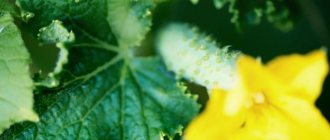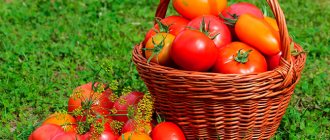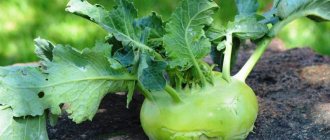Pros and cons of cold-resistant and shade-tolerant varieties
First, let's find out what is meant by cold resistance of cucumber crops. This is the name given to a cucumber’s ability to withstand and not die when temperatures drop to +2°, without slowing down the growing season. Let us note that not a single variety can withstand temperatures dropping into sub-zero temperatures; frost resistance is not inherent in cucumbers.
Cucumbers that can develop normally at low temperatures are chosen by many summer residents. In most regions of Russia, cold weather may return in May-June. What are the benefits of growing cold-resistant cucumbers:
- Continuation of vegetation processes during cold weather.
- Harvesting over a long period. Some hybrids of cold-resistant cucumbers are late-ripening, with a long fruiting period, and delight you with greens until frost.
- The ability to use fruits in any way - for pickling, canning, fresh.
- Hybrids are resistant to major cucumber diseases and pests.
Shade-tolerant cucumbers easily tolerate some lack of sunlight. This does not mean that you can plant them in a dark corner where the sun never shines.
Note: shading is allowed for some time, which cannot be long and last all day.
Most summer residents who plant cold-resistant varieties note that they can withstand temporary weather deterioration, while producing a harvest within the time period indicated in the description. There are no complaints about the taste; the aroma, delicate skin and characteristic cucumber taste are at their best.
Cucumbers for growing on the window
You can’t ignore shade-tolerant cucumbers, which are bred specifically for growing at home. They usually have few leaves, and are also characterized by limited growth of lateral shoots and prolonged fruiting.
Window F1
This is a bunch-type hybrid that forms up to 6-8 ovaries in a node. The maximum length of cucumbers is 14 cm, but cucumbers are usually harvested in the pickle and gherkin stage.
Productivity is high, but care and regular harvesting of fruits are required.
Balcony crunch F1
Another indoor beauty is an early ripening parthenocarpic under the original name Balcony Crunch.
No more than 43-45 days pass before the first harvest of fruits; fruiting is very extended. The greens are small, up to 6-8 cm, with small pimples, dense and tasty.
Handsome Hikmet F1
This hybrid presented by agro will surprise and delight you. This is a shade-tolerant cucumber, which is recommended for growing on a windowsill in winter, as well as on a loggia or balcony.
Zelentsy grow up to 10 cm, there are a lot of tubercles on the surface, and the thorns are white. The fruits have an excellent taste and are mainly used for pickling.
As you can see, the group of shade-tolerant cucumbers is very diverse, and you can always choose a variety or hybrid that will meet your needs. At the same time, do not forget about the recommendations of the manufacturers; only in this case will it be possible to get a high yield of everyone’s favorite vegetable.
Natalia Severova
Recommended growing regions
Summer residents decide for themselves whether they need cold-resistant varieties. They can be grown in any region. Excellent taste, long fruiting period and independence from the weather make hybrids in demand everywhere. Agronomists recommend the following regions of Russia for cultivation:
- middle zone, Moscow region;
- Ural;
- Siberia;
- Upper and Middle Volga region;
- northern regions.
For regions with short, cold summers, varieties with a short growing season are recommended. It is better not to choose late-ripening varieties that bear fruit in 55-70 days. Many people prefer bushy and short-climbing hybrids that ripen in record time and quickly produce a harvest. An additional plus is the small size of the bush; the plants are easy to cover at sub-zero temperatures.
Recommendations for cultivation
Varieties with high resistance rates can be cultivated in any region. But in the conditions of the south there is no need to sacrifice taste and characteristic aroma, or harvest volumes, if the threat of sudden frosts is small. The need to switch to new species will be for those who are engaged in cultivation in risky farming regions:
- in the Urals;
- in Siberia;
- in the Far East.
This is a good solution for gardeners in the Moscow region, northern Volga region, and Leningrad region. If it is possible to grow a vegetable only in open ground, while constant monitoring is not provided, there is no chance to close the plantings in case of cold weather, the right choice of variety will simplify care. In the most difficult regions, where summers are cold and cloudy, the first fruits should appear as early as possible. Therefore, late species are undesirable. Active vegetation will begin no earlier than 55-65 days after germination, however, temperatures will already drop below the permissible minimum.
From the point of view of care, such plantings are no different from ordinary ones. The main thing is to remember that severe frosts and a complete lack of light are still dangerous. Tall plants can be planted next to shade-tolerant varieties, but in small quantities. Cold-resistant ones need to be watered regularly, and the soil should be mulched and loosened. This will help increase the saturation of the soil with oxygen and make it less thermally conductive. If temperatures drop, it is better to cover the plantings with film or provide simple heating by igniting biological waste. Smoke will help cope with the settling of cold air masses.
To improve the taste, increase the size of the fruits and speed up their ripening, appropriate feeding is needed. Resistant varieties are more sensitive to overdoses of chemically active substances, so it is better to abandon mineral fertilizers in favor of organic or complex formulations.
You may be interested in:
The best varieties of cucumbers for open ground in the Moscow region Cucumbers are tender, crispy, juicy and healthy, how delicious are salads with them, how amazingly crunchy they are, lightly salted, with...Read more...
Nuances of crop care
When growing cold-resistant cucumbers, follow the usual recommendations for agricultural practices. Let us highlight several basic rules that help support cucumber crops during a sharp drop in temperature:
- mulching the soil; It is on cold soils that disease infection and growth stops faster;
- when there is a threat of frost, sprinkling is carried out - 5-10 liters per square meter;
- smoke pollution of plantings;
- covering with branches and film at night and when there is a threat of frost;
- planting around tall plants;
- the use of phytohormones and growth stimulants.
Treatment with brassinolides (Epin) helps increase cold resistance.
Description Cucumber Ira F1 0.3 g
Gardeners have been arguing about bee-pollinated cucumbers for a long time, some say that there are no better cucumbers and they are tastier and more aromatic, others praise the parthenocarpic ones, it’s up to you to choose.
Ira F1 is a classic insect-pollinated hybrid created for canning in jars, salting in a barrel and eating fresh, while the cucumber remains firm and crunchy.
The variety, with a mixed type of flowering, mainly with female flowers, feels great both in the garden and in temporary film tunnels. For better pollination by insects, you can sow honey plants (phacelia, borage) next to the cucumber bed.
Mid-season, with the beginning of fruiting on the 50-60th day from seed germination, high-yielding, with proper care, you can harvest up to 12-12.5 kg/m2
The plant is a gherkin type, indeterminate, moderately branched, and several ovaries are formed simultaneously in each internode. The leaf is small and deep green.
The fruits are smooth, medium-sized, elongated-cylindrical, 10-13 cm long and weighing up to 90 g, with large, sparsely spaced tubercles and light spines, tasty without bitterness, crispy, aromatic, do not turn yellow for a long time.
The “Ira” hybrid is relatively resistant to a whole range of diseases, but it is demanding of heat; the soil must be fertile, moist and loose.
In order for the plant to bear fruit for a long time, it is necessary to water it with warm water heated in the sun, periodically feed it with organic and mineral fertilizers and mulch the bed.
The best varieties of cold-resistant cucumbers for open ground and greenhouses
Open ground allows you to grow bee-pollinated varieties, but the best solution in cold climates are parthenocarpic species that are independent of pollination capabilities.
Cupid F1
A favorite of summer residents is the self-pollinating hybrid Amur. The first harvest is harvested 40 days after germination. It forms the lashes on its own and does not bring any special worries about pinching. The cucumbers are evenly distributed among the vines. Zelentsy – 12-15 centimeters, weight – 90-110 grams.
When grown in trellises, it is more resistant to diseases. Disadvantage: short fruiting period (month). Cucumbers are picked regularly (every 2-3 days), since when they overgrow, their taste decreases.
Valaam F1
Super early variety - 38-40 days before the first fruits appear. 5-6 greens are formed in bunches on the side shoots. The fruits are small - 5-6 centimeters, do not outgrow, large-tubercular. The shape is ovoid, the fruits have whitish stripes and are covered with a faint waxy coating.
Among the disadvantages is the harsh, dense skin, which increases the shelf life (10 days). The pulp is tender and juicy, bitterness is completely absent.
Blizzard F1
The stem of the hybrid grows unlimitedly, the side shoots are poorly developed. Bundles contain 3-5 ovaries. The fruits are small - 6-8 centimeters, when they outgrow they begin to grow in width, the cucumbers become like barrels. According to reviews from summer residents, it is better to pick greens when they are 5-6 centimeters in size, so that voids do not appear inside. Use fresh and for preparations in any way.
See also
How and when to properly plant cucumber seedlings in open ground
Read
Lapland F1
The F1 hybrid is characterized by high tolerance to low temperatures, fully justifying its name. Vegetation is not slowed down by cold weather. When the autumn temperature drops, the ovaries continue to develop, the greens grow. Cucumbers grow in bunches of 3-6 pieces. The fruits are 8-9 centimeters, dark green in color, with indistinct stripes. Does not require pollination - grown openly and in greenhouses.
Important: cold-resistant hybrids are recommended to be planted as seedlings.
Tundra F1
The hybrid with the harsh name is successfully grown under a combination of low temperatures and little sunlight. At the same time, the bushes fully bloom and form fruits. Parthenocarpic, does not require pollination. Cucumbers with thick skin and juicy pulp. Size – 6-8 centimeters, in nodes – 3-4 cucumbers. The hybrid was bred for cultivation in northern regions; it sets fruit until frost.
Eskimo F1
Cucumbers show high cold resistance; at 5-7 ° they do not slow down the growing season. Parthenocarpic hybrid with cylindrical fruits, weighing up to 110-120 grams.
The bush has little climbing and is not very thick with foliage, it is easy to care for, and it is convenient to pick cucumbers. It is well ventilated, so it practically does not get sick. The thick skin retains crispness when pickled, and the beautiful fruits look good when preserved in jars.
Dolomite F1
A hybrid of Dutch selection with medium-sized bushes with few branches. Cucumbers are finely tuberculate with dense pubescence. Zelentsy are strewn with small tubercles. The fruits are smooth and of the same size. Convenient to collect at the pickle stage.
Does not require pollination. They tolerate any stress well, including lack of heat and moisture. They recover quickly and continue the growing season. Very tasty when marinated.
Eliseevsky F1
Flowering is mixed, pollinated by bees. Belongs to mid-season, ripening period is 55-60 days. Does not require gartering or bush formation. The fruits are juicy, fragrant, length – up to 11 centimeters. Traditionally used for pickling in barrels.
Ant F1
Hybrid Ant grows well in greenhouses and open ground. This species is often grown in apartments. Does not require pollination. Bundle form of ovary formation - 3-7 pieces. Zelentsy with a large number of tubercles grow up to 110 grams, and are genetically devoid of bitterness.
Mill
The remarkable elongated fruits (15-18 centimeters) of the Melnitsa hybrid have large tubercles. Belongs to the high-yielding hybrids of the Zozulya group.
They grow well in unheated greenhouses and open ground. Excellent taste, cucumbers are used fresh and in preparations.
Cheboksary
Early ripening Cheboksary begins to bear fruit in 36-38 days. Grows well at low temperatures and lack of watering. Zelentsy are smooth, densely covered with small bumps. Suitable for growing in winter greenhouses. Can be used in any form.
Saltan
Hybrid Saltan begins to bear fruit after 45-48 days from successful shoots. Among the advantages are the possibility of a long harvest and high resistance to fungal diseases.
Suomi
The Finnish name is the Suomi hybrid. The first cucumbers will appear on the table in 35 days. Plants easily tolerate temperature fluctuations without slowing down the growth of ovaries and greens. Finely tuberous cucumbers grow up to 7-9 centimeters, are suitable for canning whole in jars, and are also tasty fresh.
Cheetah
The Cheetah hybrid is parthenocarpic; cucumbers set without pollination. The surface of the fruit is tuberculate, size is up to 15 centimeters. Resistant to fungal diseases.
Cucumbers At the behest of the pike
The hybrid with a fabulous name bears fruit until late autumn and easily tolerates low temperatures. The “pike” hybrid is a parthenocarpic, the bush grows in one stem, there are few side shoots.
The fruits of the hybrid At the behest of the pike are sweet, juicy, smooth, and store well.
TLC
Hybrids of the TSH or TSHA series (442, 28) are types of cucumbers with different methods of pollination. Recommended for growing in winter greenhouses, where they produce high-quality greens (elongated, 18-22 centimeters). Shade-tolerant and cold-resistant.
See also
Instructions for use of Cucumber Rescuer, when to process
Read
Shade-tolerant bunched cucumbers
In recent years, among the favorites of gardeners are hybrids and varieties with bouquet (beam) arrangement of ovaries. In “ordinary” cucumbers, the number of ovaries in the nodes is 1-2 (occasionally three), while these ones have from 4 to 10 pieces.
The group of shade-tolerant cucumbers also has such representatives, so we recommend getting to know the record holders.
Karapuz F1
This hybrid produces up to 5 greens in each bosom, and it is characterized by very high remontancy. The hybrid does not require pollination and grows well in open ground and in greenhouses.
Zelentsy - up to 7 cm, smooth, strong, real Peaches, with excellent taste.
This cucumber is considered one of the best for preservation.
ON A NOTE! Gives best results at moderate temperatures; in hot weather it reduces yield.
Hit of the F1 season
A very early ripening hybrid that bears fruit even in unfavorable conditions. Refers to bunch cucumbers, greens - up to 12 cm, crispy, dense.
From 5 to 7 ovaries are formed in a node, so the plant must be provided with adequate nutrition. Grows well in shaded areas and does not reduce productivity in cloudy weather. Cucumbers are used for pickling and canning.
Chistye Prudy F1
This productive hybrid of the Chistye Prudy cucumber produces up to six ovaries in one node. It was bred agro, and has proven itself well in risky farming zones. Zelentsy are very beautiful, up to 17 cm, excellent taste.
Feature of the hybrid: At the beginning of the growing season, it does not require, like other cucumbers, intensive fertilizing with nitrogen.
Cucumbers are used for making salads and for pickling.
Maryina Roshcha F1
This hybrid, characterized by long-term fruiting, also belongs to bunch-type cucumbers. Having provided the plant with good care, cucumbers can be harvested until autumn.
Its fruits are white-thorned, up to 12 cm in length, and tasty. The number of ovaries in the nodes is up to 4-5 pieces; about 12 fruits ripen on the bush at the same time. Zelentsy have dense, aromatic pulp and are universally used.
Such hybrids as Green Wave F1 and Be Healthy F1 also performed very well.
Recommended shade-tolerant varieties with descriptions and reviews
Shade-tolerant varieties are among the leaders among summer residents who have small plots where it is difficult to find a lot of space for cucumber beds. Reviews about these hybrids are usually excellent - the main thing is that the bed should still be in the sun part of the day.
Muromsky 36
One of the old popular varieties that tolerates regular drops in temperature and lack of light. Sings quickly - 36-38 days. It is not particularly productive, but it is highly reliable. It is better to pick cucumbers earlier (8 centimeters), since the marketability and taste are lost - the greens turn yellow and become coarse.
F1 company secret
Greens of the hybrid Secret of the Company grow up to 14 centimeters and have a sharp tip. Suitable for any method of use. Large branched bushes should not be planted close to each other; tying and pinching should be carried out in a timely manner.
Moscow evenings F1
In the average period (45 days), self-pollinating hybrids of this species mature. The bush is climbing and requires staking. The quality of the cucumbers is excellent - sweet and juicy, weight - up to 110 grams. Used in all ways.
F1 athlete
The shade-loving hybrid requires some shading to prevent the cucumbers from becoming bitter. The powerful central stem grows all season up to 3 meters. The fruits are elongated (20 centimeters), with large tubercles. Cucumbers have a good crunch when pickled or fresh.
Topolek F1
Hybrid with small cucumbers, pollinated by bees. Zelentsy with a large number of tubercles, excellent presentation and taste. Fruiting time is 110-130 days. The first cucumbers appear after 43-48 days. Universal use.
Berendey F1
The hybrid cucumber will ripen in 50 days and is a mid-season species. Summer residents like it for the opportunity to grow in conditions of increased shade, in small areas, with an excess of plantings.
The size of the fruit is 12-14 centimeters, with small white spines. Delicious fresh and prepared.
Maryina Roshcha F1
The bunch hybrid tolerates a lack of light well, but when grown in the sun, the number of ovaries and greens increases significantly. The fruits have light thorns and grow up to 12 centimeters. The bush bears fruit until a persistent cold snap occurs.
Arbat F1
Arbat is classified as a shade-loving hybrid. Bushes with many side shoots need reliable staking. The skin of the fruit is smooth and tender; cucumbers grow up to 15 centimeters. Salad qualities are excellent, they retain crispness well in preparations. According to reviews from most summer residents, they ripen quickly in cold summer conditions with few sunny days.
Manul
Hybrid Manul belongs to the group of bee-pollinated animals. Excellent taste and elongated cylindrical fruits make cucumbers of this type popular among summer residents. Productivity – up to 7 kilograms per bush.
Zadavaka
“Don’t give up in the dark” is the task of Zadavak cucumbers, indicated on the seed packet. The bushes grow well with a lack of sun. The greens of the hybrid are smooth, up to 8 centimeters, with large bumps. The purpose is universal.
Lord
The first generation hybrid Lord is characterized by the rapid growth of the stem and side shoots. Requires bush formation and garters. Cucumbers are smooth, bright green, up to 11 centimeters. It bears fruit well at the end of summer, when there is little solar heat and light.
Danila
Hybrid Danila produces fruits up to 15 centimeters in size, used for pickles, pickling and fresh. Early ripening cucumbers easily tolerate shade and lack of sunlight. They are stored for a long time without losing taste and freshness. They sing very well, summer residents use the hybrid for harvesting.
Flagship
One of the cold-resistant varieties, grows well with a lack of sun. The hybrid has a mid-early ripening period, the first harvest is harvested in 45-47 days. The flagship grows up to 10 centimeters, the application is universal.
Balalaika
The Balalaika hybrid produces stable yields when the beds are shaded. The bush is small in size, without pronounced branching. Zelentsy are even, up to 11 centimeters, with good taste and aroma. The yield decreases due to droughts and insufficient watering.
Reviews
Olga
Completely switched to shade-tolerant species, dacha in Leningrad region. Cucumbers ripen much faster, and there are fewer crooked fruits. The Berendey variety turned out to be especially successful; it is perfectly stored even at room temperature.
Victor
I like the variety “Maryina Roshcha”. Unlike the more famous Athlete, these cucumbers do not become bitter when grown in hot weather or in the sun. On the contrary, there are more ovaries, and accordingly the harvest is impressive.
Shade-loving, cold-resistant cucumbers produce fruit under the most unfavorable conditions, and at the same time do not require special care. The technology of planting, gartering, shaping, and watering is no different from the usual; you don’t even need to worry about shelters during the inevitable cold snaps at the end of summer. The main advantage of such species is their long fruiting period. But there are drawbacks, for example, some varieties do not like too hot weather and begin to taste bitter if there is a lack of moisture. Therefore, it is important to choose a hybrid suitable for specific conditions.
How to get a harvest of cucumbers in cold summer
First, check the long-range weather forecast for your area. What do the services promise: drought, rain, heat, cold?
„„To increase cold resistance, cucumber seeds are hardened and treated with stimulants. A week before planting in the ground, seedlings are kept at temperatures up to +16...+18 °C. In good weather, you can take it out onto the balcony, but just do not place it in direct sunlight.
„„If the forecast predicts a cold June, planting in open ground begins as soon as the threat of frost has passed and the soil has warmed up. Covering plants with lutrasil or film will help protect plants from cold weather. Don't rush to take it off! If you remove the cover in cold weather, the growth of plants and fruits will stop. Due to abrupt changes in the growth rate, crooked or “constricted” fruits may appear. Only when the weather is very hot and the covers can cause leaf burns are they opened slightly during the daytime. If you remove the covers completely, the plants are early damaged by powdery mildew. For ventilation, it is enough to raise the shelter on one side.
Cucumbers are a moisture-loving crop, but in cool and rainy weather the frequency and volume of watering should be reduced. In greenhouses and greenhouses, plants are watered in the first half of the day only with warm water (not lower than +18...+20 °C). „„During prolonged cloudy weather, it is recommended to feed the plants leaf by leaf with complex water-soluble fertilizers with microelements at a concentration of 0.1% (1 g of fertilizer per 1 liter of water).
Often, due to sudden changes in temperature, plants stop growing vegetative mass and instead form a large number of female flowers with ovaries at the top of the shoot. If the topping is not strong, you need to remove the ovaries or greens at the bottom of the stem and several large ones at the top; if it is strong, all the ovaries and flowers at the top are removed. Feed the plants leaf by leaf with nitrogen fertilizers or growth stimulants (Epin-extra, Zircon).
Advantages and disadvantages
Cold-resistant cucumbers are popular because they allow early harvests even in risky farming areas.
Among the advantages of hybrids:
- different timing of harvesting greens (early, mid-season and late species were bred);
- resistance to adverse weather conditions;
- resistance to diseases and infections;
- high harvest rates of green cucumbers (among the cold-resistant cucumbers there are many representatives of the bouquet type);
- good taste;
- versatility of application.
Shade-tolerant cucumbers are suitable for those summer residents who have small plots. In small areas it is difficult to distribute all the plantings, taking into account the plants’ needs for lighting and protection from winds. Cucumber varieties that can withstand slight shading are planted under the crowns of bushes, near fences and outbuildings. This does not reduce their productivity, and the owners get the opportunity to plant more capricious crops in well-lit areas.
Characteristics of the variety
An early-ripening parthenocarpic hybrid that does not require pollination by bees. Flowering type: female. It takes 40 days from the first shoots to harvest. Plants are indeterminate, medium-sized and wiry. From 1 to 3 cucumbers are formed in the leaf axils.
Description of the fruit: finely lumpy green in color; when gherkins are harvested, they reach a size of 70–90 grams, with a size of 9–11 centimeters. Short yellow stripes and dense pubescence are visible on the surface.
Zelentsy are dense, there are no voids when cut. The seeds are small, the taste is sweet cucumber without bitterness. The yield is about 5 kilograms per 1 square meter of cucumber planting with proper care.
The variety is intended for universal use. Suitable for fresh consumption and pickling. They are not resistant to overgrowth. When harvested, 94% of the fruit retains its presentation.
Growing conditions and methods
To get a good harvest of Ira f1 cucumbers, they need to be grown
It is important to choose the right land for cultivation. It should be fertile, not sour, light
At the end of the season, the soil is prepared in advance - compost is added and dug up. In spring, this soil does not need to be fertilized. All you have to do is dig again and prepare the beds. To prevent bacteria from developing in the soil, it is spilled with hot water and potassium permanganate, then covered with plastic wrap for a week. After these activities, the soil is ready for planting.
If you decide to plant Irina cucumbers in a greenhouse, then planting should be done in mid-May. The main condition is that there are no night frosts and the air temperature does not fall below 15 degrees. Otherwise the landings will be lost. Cucumbers are usually planted in rows with a distance of 50 centimeters between them. The width between planted plants is from 20 to 40 centimeters. Depends on the area of the bed and growing conditions.
Seeds are planted to a depth of 1.5–2 centimeters. You can’t plant them any deeper, they simply won’t germinate. After planting the seeds, the bed can be covered with film for better germination, but before that it is watered with warm water at room temperature. When cucumber sprouts appear, remove the film and continue to grow. It must be remembered that this is a tall variety, so the lashes are let along a trellis or tied to a crossbar. Whoever likes it more. Also indoors it is necessary to provide access for insects to pollinate flowers. Otherwise there will be no harvest.
Understanding the terminology
At the very beginning, you need to understand the concept of “cold resistance” so as not to get into trouble when choosing a cucumber variety. It is clear that this characteristic means the ability of cucumbers to withstand cold snaps, but there is no talk of any sub-zero temperatures. For cucumbers, the minimum temperature will be +2 ºC…+3ºC.
This will be the limit that the plants can withstand, since lower rates lead to the death of the crop. Frost resistance means the ability to withstand certain subzero temperatures, which is unacceptable for cucumbers. Therefore, when packages describing cucumber hybrids or varieties talk about frost resistance, you need to understand that this is just advertising.
But the group of cold-resistant cucumbers is quite representative; many hybrids have been bred recently and successfully tested in the regions of Siberia, beyond the Urals, and in the regions of the North-West.
It is these areas that are characterized by short and cool summers (although there are exceptions) and frequent rains, so varieties of cold-resistant cucumbers are primarily intended for them.
How to choose the right variety
- Where will the vegetable be grown? As a rule, “green ones” grow in a greenhouse, hotbed or open ground. It is not uncommon to grow them on a windowsill.
- When would you like to get the harvest? You can enjoy young cucumbers already in early June. The most patient are willing to wait until July or August.
- How long would you like to harvest cucumbers?
According to this principle, “greenies” are conventionally divided into early, middle and late. It is worth remembering that early plant varieties are more likely to get sick. In addition, compared to later ones, they have a shorter fruiting period. If the cucumber variety is chosen correctly, they are not afraid of either false or real, or bacteriosis
The main thing is to pay attention to the increased resistance of plants to these scourges.
It is worth deciding what vegetables are needed for. After all, some people prefer to pickle them, while others don’t mind crunching fresh ones. And here they distinguish salad, pickling and universal varieties. Naturally, each of them has certain advantages.
Cucumber Kuzya F1
Cucumber Kuzya F1 is an ultra-early ripening parthenocarpic hybrid for open and protected ground, which begins to bear fruit on the 38-40th day from germination. Using this hybrid, you will see a real inflorescence of gherkins on each plant, 3-5 ovaries are formed in each node, and the greens do not exceed 5-7 cm. The cucumbers are smooth, finely tuberculate, dark green with white pubescence and completely without bitterness. Ideal for canning and pickling in the form of pickles and mini gherkins. The hybrid has increased resistance to diseases such as downy and powdery mildew and cucumber mosaic virus.
Watch our video about these wonderful hybrids and choose yours
And in order to be guaranteed to get the maximum amount of harvest from one plant, we suggest you take note of the scheme for the formation of parthenocarpic hybrids in a greenhouse:
Dear gardeners! Almost every one of you, when growing classic varieties of cucumber, has encountered problems such as: empty flowers, diseases, bitter fruits and often a weak harvest. New times require new solutions. Using its many years of experience, AELITA Agrofirm offers you new parthenocarpic hybrids with bunched ovaries. With these hybrids, you are guaranteed to get crispy, juicy, appetizing cucumbers that will delight you not only on the table in the summer, but also in pickles all year round.
We have also prepared for you the material “So what is parthenocarpy, hybrids and GMOs?”, which will help you understand the intricacies and boldly choose for yourself new hybrids, created taking into account new times.
Have a successful harvest and good health in the new year!
The full range of cucumber varieties and hybrids of the AELITA Agrofirm can be found here.
Subtleties of growing greenhouse varieties of cucumbers
Parthenocarpic hybrids are grown in greenhouses: they are able to set fruit without pollination. Naturally, greenhouse conditions allow harvesting to take place over a period of 2 months or more, which means that it is better to choose hybrids with good or moderate branching. But when temperature changes, greenhouse cucumbers are often affected by fusarium, so pay attention to the hybrid’s resistance to this fungal disease. And finally, do not forget that you cannot stop choosing one hybrid, no matter how good it is - even one stress factor can leave you without a cucumber harvest. Plant at least two or three hybrids.
